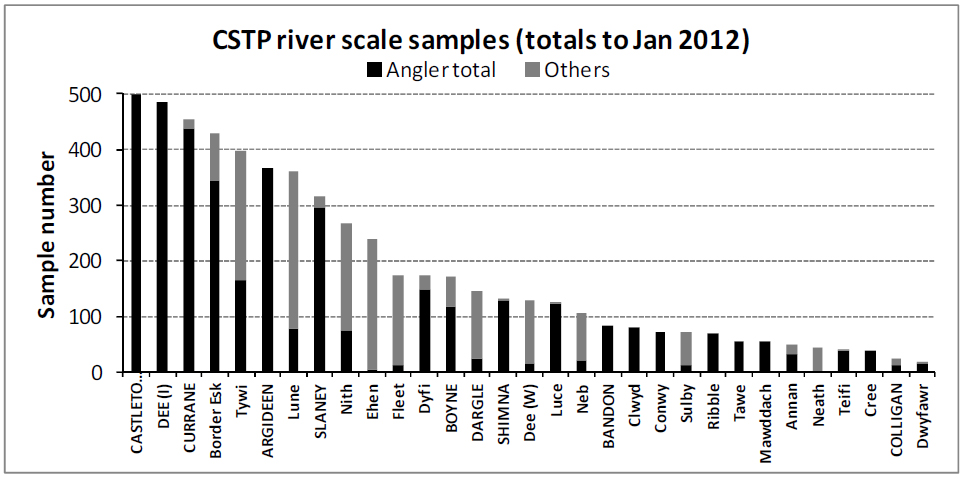Introduction
The Celtic Sea Trout Project (CSTP) is a European Union, Interreg IVA-funded, Ireland-Wales collaborative project on the status, distribution, genetics and ecology of sea trout around the Irish Sea. This note briefly outlines progress in 2011 for the many helpers and participants in angling clubs, river trusts and other organisations. More detailed technical accounts will be available in due course.
Sampling
The CSTP is reliant upon effective field sampling to collect data and material such as scales from fish for the scientific analysis. For example, the genetics and microchemistry analysis, that will tell us about the mixing and distribution of stocks, requires a baseline of measurements to be made in all the principal rivers around the Irish Sea which are likely to contribute to sea trout stocks. River sampling of juvenile
trout for the genetics was the focus of the CSTP scientific team’s work in 2010 and was completed in 2011, using a large scale electro-fishing programme, taking samples from around 80 rivers.
Sampling in the sea
Marine sampling of sea trout is a key part of the project because it has not been done before in the Britain and Ireland. We want to know, amongst other things, where they go, what they feed on and how fast they grow. This is a challenging task but the CSTP team has made good progress. We have had to develop new methods for trawl sampling and have used them successfully in surveys from Dublin to the Solway coast, via the Isle of Man. Shore sampling along the coasts of Wales, England and Scotland has proved more difficult; but the collections are still sparse and the marine sampling, including trawl sampling off Cardigan Bay and South Wales, will be intensified in 2012. Shore sampling in Ireland has yielded good results and this programme will be expanded in 2012.
Sampling in rivers
A major part of the sampling programme is the collection of scales for analysis of life histories, and growth rates. For this purpose we need to know which rivers they came from and, apart from fish traps of which there are only three across the whole CSTP area (Tawe, Dee and Lune), the sampling of adults in rivers has to be done by angling. This part of the sampling programme has required extensive communication with angler groups and distribution of thousands of sampling kits and scale envelopes. Several talks on the CSTP were given during the winters of 2008/9, 2009/10 and 2010/11 to clubs and associations across Wales, Ireland, Scotland and England. We aim to collect scales from at least 300 adult sea trout from each of the selected rivers over the project. 2
The scale sampling to date has had mixed fortunes, bearing in mind the target of 300 (Fig 1). The participation has been very good with over 1,600 anglers sending in 3974 sets, of which 2,322 came in 2011; so a big THANK YOU for all of those. Some rivers have done particularly well, such as the Border Esk, the Irish Dee, Argideen, Castletown and Currane, and on others some of the shortfall has been made up with other forms of sampling. We will continue the sampling in 2012.
Sample processing and data analysis
Genetic analysis at University College Cork and Bangor University has been completed to establish a baseline of genetic variation and has shown remarkably strong structuring, with patterns that appear to reflect the ancient glacial history of the Irish Sea. This information will be used to assign marine sea trout to their regions or rivers of origin, in order to learn how they distribute themselves at sea. Scales from the past two years are currently being read and analysed and are being used to derive the ages, spawning history and growth rates of individual fish throughout their lives in rivers and sea. .The bulk of this time-consuming work will be done by summer 2012. Other tasks on sea trout marine feeding, marine distribution modeling and fisheries analysis will be completed during 2012. The other work includes dissecting organs and tissues from 2000+ adult fish, microchemical analysis of the inner ear bones, measuring and weighing 5,000+ fry, and scale reading and analysis of the large historical collection of scales that the CSTP has brought together. So, coupled with the year round sampling, the scientists are fully occupied.
Sampling by anglers in 2012
The prize draw for the champion scale samplers will be held in Carmarthen 21st March 2013, but the CSTP needs the continued support of anglers in 2012. Scales can be taken easily once you have the basic kit which we provide. CSTP project team members are available to present talks to your club if required. Contact us through the CSTP website. THANK YOU FOR YOUR CONTINUING ASSISTANCE.

